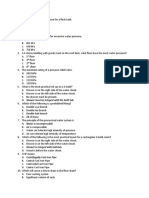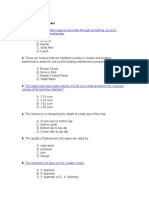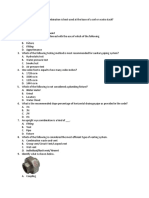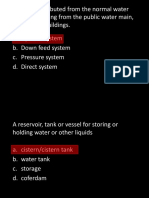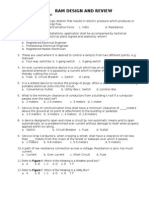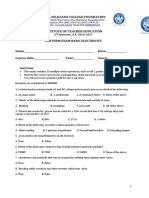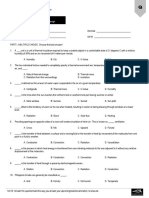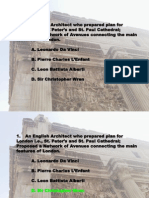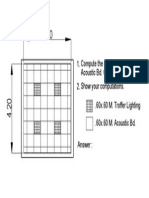Elec 9103 - El 03 - Questionnaire
Elec 9103 - El 03 - Questionnaire
Uploaded by
Sam DichosoCopyright:
Available Formats
Elec 9103 - El 03 - Questionnaire
Elec 9103 - El 03 - Questionnaire
Uploaded by
Sam DichosoOriginal Description:
Copyright
Available Formats
Share this document
Did you find this document useful?
Is this content inappropriate?
Copyright:
Available Formats
Elec 9103 - El 03 - Questionnaire
Elec 9103 - El 03 - Questionnaire
Uploaded by
Sam DichosoCopyright:
Available Formats
ELECTRICAL SYSTEM
EXAMINEE:
RATING:
TOPIC CODE: EL 03-04
DIRECTION: Select the correct answer.
ITEM
QUESTION & CHOICES
ANSWER
B
B
Who is considered the Father of Electricity? A. Henry Williams B. William Gilbert C. Gilbert Morris
What is the force that makes the electrons move in a circuit? A. MEF B. EMF C. EEF D. MBF
A circuit line extensions of a feeder, fed through a panel board or cut-out, or from one distributing center
to another and having no other circuit connected to it between the two distributing centers. A sub-feeder
serves to distribute power from the main feeders to smaller local panel boards, called sub-panel boards.
A. Sub-Feeder Circuits B. Feeder Circuits C. Extend Circuits
What source of electricity used to supply emergency lighting circuits for hallways, stairways, exits and to
energize police and fire systems and certain types of signal systems? A. Generators B. Storage Batteries
C. Transformer D. Rotary Converters
These serve to control and protect the sub feeders and branch circuits. A. Branch Circuits B. Utilization
Equipments C. Utilization Branch Equipment D. Panel Boards and Sub-Panel Boards
The bulk of electrical energy utilized today is in the form of alternating current, including energy for power
and lighting. A. Direct Current Generators B. Alternators C. Transformer D. Rotary Converters
These furnish electrical energy for elevators, escalators, intercommunicating telephone systems, control
of signal systems and clock systems? A. Direct Current Generators B. Alternators C. Transformer
A switch that automatically interrupts an electric circuit to prevent excess current from damaging
apparatus in the circuit or from causing a fire. A circuit breaker may be reclosed and reused without
replacement of any components. A. Circuit Breaker B. Service Switch C. Panel Switch D. Bus Breaker
The main disconnector for the entire electrical system of a building except for any emergency power
systems. A. Circuit Breaker B. Service Switch C. Panel Switch D. Bus Breaker
10
What is an electric machine for converting one voltage to another, from lower to higher of vice versa? A.
Generator B. Storage Batteries C. Transformer D. Rotary Converters
11
What is an electric machines for changing alternating current to direct current and vice versa? A.
Generator B. Storage Batteries C. Transformer D. Rotary Converters
12
A heavy conductor, usually in the form of a solid copper bar, used for collecting, carrying and distributing
large electric currents. A. Panel B. Service Panel C. Panel Switch D. Bus
13
An electrical circuit may be defined as a complete conducting path carrying current from a source of
electricity to and through some electrical device or load and back to the source. The two wire circuit,
which is the most elementary of all wiring systems, consists of a live wire carrying the current to the
various power consuming devices in the circuit and a neutral or grounded wire which is the return wire
carrying the circuit back to the source of supply. A. Parallel circuit B. Series circuit C. Branch Circuit D.
Individual Branch Circuit
14
A horizontal single line diagram of the buildings electrical system from the incoming service to the
utilization items at the end of the system where the major electrical components are shown as blocks or
rectangles. A. Riser Diagram B. Block Diagram C. Single Line Diagram D. Riser Block Diagram
15
One in which the components are connected in tandem. All separate loads of the circuit carry the same
equal current and the total resistance, R, is the sum of the resistances around the circuit. A. Parallel
circuit B. Series circuit C. Branch Circuit D. Individual Branch Circuit
16
A vertical line diagram of the major electrical components of the buildings electrical system presented
showing the spatial relations between components. A. Riser Diagram B. Block Diagram C. Single Line
Diagram D. Riser Block Diagram
Reference: Architect Maila Quebec, uap
SAMONIAN DIGITAL LIBRARY
Dubai, United Arab Emirates
1|3
REMARK
ELECTRICAL SYSTEM
EXAMINEE:
RATING:
TOPIC CODE: EL 03-04
DIRECTION: Select the correct answer.
ITEM
QUESTION & CHOICES
ANSWER
17
One in which the components or loads are so arranged that the current divides between them. Each outlet
has a live wire connected to the current carrying wire of the circuit and also a neutral wire or grounded
wire connected to the return wire of the circuit. With this system, the total current flowing through the
circuit is the sum of the current flowing through each outlet. A. Parallel circuit B. Series circuit C. Branch
Circuit D. Individual Branch Circuit
18
A fabricated assembly of insulated conductors enclosed in flexible metal sheath. A. Metal Clad Cable
(Type MC) B. Armored Cable (Type AC) C. Mineral Insulated Cable (Type MI) D. Non-Metallic Sheathed
Cable (Type NM or NMC)
19
For industries and large commercial buildings, the lighting and outlet loads are connected between any
phase leg and a neutral line. While machineries and other bigger loads are connected to the phase leg
only. A. Three Phase Electrical Systems B. Triple Phase Electrical Systems C. Two Phase Electrical
Systems D. Single Phase Electrical Systems
20
Any of several conducting rods installed at the top of a structure and grounded to divert lightning away
from the structure. A. Lightning Rod B. Lightning Arrester C. Spark Gap D. Lighting Gap
21
A factory assembled conductor/s insulated with a highly compressed refractory mineral insulation
enclosed in a liquid and gas tight continuous copper sheath. A. Metal Clad Cable (Type MC) B. Armored
Cable (Type AC) C. Mineral Insulated Cable (Type MI) D. Non-Metallic Sheathed Cable (Type NM or
NMC)
22
A device for protecting electric equipment from damage by lightning or other high-voltage currents, using
spark gaps to carry the current to the ground without passing through the device A. Lightning Rod B.
Lightning Arrester C. Spark Gap D. Lighting Gap
23
Also known by the trade name ROMEX, is a factory assembly of two or more insulated conductors having
a moisture resistant, and flame retardant. A. Metal Clad Cable (Type MC) B. Armored Cable (Type AC) C.
Mineral Insulated Cable (Type MI) D. Non-Metallic Sheathed Cable (Type NM or NMC)
24
A Circuit is a set of conductors which extends from the main switchboard to a distributing center (panel
board) with no other circuits connected to it between the source and the distributing center. A. Sub-feeder
Circuits B. Feeder Circuits C. Extend Circuits
25
Insulator is to protect the enclosed conductors from mechanical injury and chemical damage, the
surroundings against fire hazard as a result of overheating or short circuiting of the enclosed conductors
and support the conductors. A. TRUE B. FALSE it should be conduit
26
Its installation is much easier and quicker than that of rigid metal conduits. Unlike the rigid conduits which
come in short lengths of 10 ft. (3 M), flexible metal conduit wiring comes in length of 25 ft 250 ft (8 M
83 M) depending on the size of the conduit A. Armored Cable Wiring (Bx Wiring) B. Flexible Metal
Conduit Wiring C. Surface Metal Raceway Wiring D. None Of These
27
Heavy-wall steel conduits with an approximate thickness of 0.117 mm also called ______. A. Rigid Steel
Conduits or RSC B. Intermediate Metal Conduit or IMC C. Electric Metal Tubing or EMT. D. Electric
Insulated Tubing or EIT.
28
Consists of rubber or thermoplastic covered wire protected from injury to a certain extent from dampness
by one or two layers of flexible steel armor. A. Armored Cable Wiring (Bx Wiring) B. Flexible Metal
Conduit Wiring C. Surface Metal Raceway Wiring D. None Of These
29
Thin-wall steel conduits. A. Rigid Steel Conduits or RSC B. Intermediate Metal Conduit or IMC C.
Electric Metal Tubing or EMT. D. Electric Insulated Tubing or EIT
30
The wires are supported on a thin sheet steel casing. The raceway is installed exposed, being mounted
on the walls or ceiling. Metal raceways must be continuous from outlet to outlet or junction box, designed
especially for use with metal raceways. A. Armored Cable Wiring (Bx Wiring) B. Flexible Metal Conduit
Wiring C. Surface Metal Raceway Wiring D. None Of These
Reference: Architect Maila Quebec, uap
SAMONIAN DIGITAL LIBRARY
Dubai, United Arab Emirates
2|3
REMARK
ELECTRICAL SYSTEM
EXAMINEE:
RATING:
TOPIC CODE: EL 03-04
DIRECTION: Select the correct answer.
ITEM
QUESTION & CHOICES
ANSWER
31
RSCs and IMCs use the same fitting, called______________, and are threaded alike at the joints. EMTs
are not threaded but use set screw and pressure fitting and are not recommended for embedding in
concrete no permitted in hazardous areas. IMC yield a larger inside diameter (ID) for easier wire pulling
and is lighter than the RSC. Standard length of steel conduits is 3 M or 10 ft. A. Conduits B. Condulets C.
Steel Conduits D. None of these
32
A factory-assembled channel with conductors for one to four circuits permanently installed in the track
that will act as light duty (branch circuit) plug-in busways. A. Armored Cable Wiring (Bx Wiring) B.
Lighting Track C. Cable Tray / Open Raceway D. None Of These
33
What channels or wiring accessories so designed for holding wires, cables and bus bars that are either
made of metal, plastic, or any insulating medium? A. Service Line B. Raceways C. Service Drop D. None
of these
34
Continuous open support for approved cables. When used as a general wiring system, the cables must
be self-protected, jacketed types, type TC. A. Armored Cable Wiring (Bx Wiring) B. Lighting Track C.
Cable Tray / Open Raceway D. None Of These
35
An assembly of primary switch-fuse-breaker, step-down transformer, meters, controls, bus bars and
secondary switchboard. It is used to supply power from a primary voltage line to any large facility. A.
Panelboards B. Unit Substations C. Switchboards
36
___________is a point in the wiring system at which current is taken to supply utilization equipment. It
refers only to the box. __________ is the wiring device in which the utilization equipment (appliance) cord
is plugged into. A. Convenience Outlet or Attachment Cap B. Lighting Outlet & Receptacle Outlet C.
Convenience Outlet and Receptacle D. Outlet and Receptacle
37
Poles and transformer supports shall be located not more than _____ inside from the road right-of-way or
property line, and shall not obstruct the sidewalk, pedestrian path and/or the road drainage canal or
structure, existing or proposed. A. 300mm B. 200mm C. 500mm D. 900mm
38
This is a free standing assembly of switches, fuses, and/or circuit breakers whose function normally is to
provide switching and feeder protection to a number of circuits connected to a main source. A.
Panelboards B. Unit Substations C. Switchboards
39
Clearances over roof. Conductors shall have a clearance of not less than ______ from the highest point of
roofs over which they pass with the following exceptions: A. 2 m B. 2.5 m C. 3 m D. 2.8 m
40
It is simply the box wherein the protective devises are housed from which the circuits and bus bars
terminate. A. Panelboards B. Unit Substations C. Switchboards
41
Exception No. 1. Where the voltage between conductors does not exceed 300 volts and the roof has a
slope of not less than 100mm in 300mm, the clearance may not be less than ___. A. 1 m B. 2 m C. 3 m
D. 2.8 m
Reference: Architect Maila Quebec, uap
SAMONIAN DIGITAL LIBRARY
Dubai, United Arab Emirates
3|3
REMARK
You might also like
- 18 Edition Mock TestDocument76 pages18 Edition Mock Testnkxqbwqk22No ratings yet
- Ironies of AutomationDocument5 pagesIronies of Automationshawnlix73No ratings yet
- Helena Catalogue EpDocument19 pagesHelena Catalogue EpfelixNo ratings yet
- Review Theory of ArchitectureDocument7 pagesReview Theory of ArchitectureiloilocityNo ratings yet
- Batas Pambansa BLG 220 - Summary & ExamsDocument26 pagesBatas Pambansa BLG 220 - Summary & ExamsSam Dichoso100% (3)
- Architecture of The PhilippinesDocument9 pagesArchitecture of The PhilippinesSam DichosoNo ratings yet
- Heat-Transfer-Formula-Sheet Print PDFDocument28 pagesHeat-Transfer-Formula-Sheet Print PDFAz Zahra AzmiNo ratings yet
- PLUMBINGDocument4 pagesPLUMBINGSheila SernaNo ratings yet
- B. Technical Drawings and SpecificationsDocument5 pagesB. Technical Drawings and SpecificationsLoren ViejayNo ratings yet
- BLDG - Utilities Preboard Exam 2008 QUESTIONNAIRE ONLYDocument24 pagesBLDG - Utilities Preboard Exam 2008 QUESTIONNAIRE ONLYJas CariñoNo ratings yet
- Plumbing ReviewDocument1 pagePlumbing ReviewSam DichosoNo ratings yet
- Building Laws Building Utilities - Unrecognizable TextDocument32 pagesBuilding Laws Building Utilities - Unrecognizable TextAlecsisRoeEstañolFrasco100% (1)
- 1 Board Exam SampleDocument5 pages1 Board Exam SampleKatrissa YoungNo ratings yet
- RMP Sample QuestionsDocument14 pagesRMP Sample QuestionsJenny-Rose Olaer CabayacruzNo ratings yet
- PlumberDocument8 pagesPlumberKristin MatubisNo ratings yet
- 08 - Set A - Plumbing & Sanitary Systems-1 PDFDocument12 pages08 - Set A - Plumbing & Sanitary Systems-1 PDFAndrew Sardañas HumirangNo ratings yet
- Lesson 3 Plumbing Fixtures Part 1Document19 pagesLesson 3 Plumbing Fixtures Part 1Junnaz BalacuitNo ratings yet
- Study Stack - Master Plumber Table ReviewDocument10 pagesStudy Stack - Master Plumber Table ReviewIvilyn RachoNo ratings yet
- Plumbing and Sanitary SystemsDocument9 pagesPlumbing and Sanitary SystemsAlexander PiniliNo ratings yet
- Mechanical and Electrical SystemsDocument18 pagesMechanical and Electrical SystemsAlexander PiniliNo ratings yet
- Plumbing Questions. ProprofsDocument33 pagesPlumbing Questions. ProprofsChristine Joyce RoseteNo ratings yet
- Plumbing TerminologiesDocument13 pagesPlumbing TerminologiesMariane PadullaNo ratings yet
- QuizDocument204 pagesQuizJethro QuiritNo ratings yet
- Mega Practical 1-3Document10 pagesMega Practical 1-3Reymond IgayaNo ratings yet
- 08 HardwareDocument32 pages08 HardwareRuri ChanNo ratings yet
- KodigsDocument27 pagesKodigsReynald HarrisNo ratings yet
- Master Plumber Elements Bank - 03 QuestionsDocument18 pagesMaster Plumber Elements Bank - 03 QuestionsjaymarNo ratings yet
- Artisan PlumbingDocument5 pagesArtisan PlumbingJulius Kiprop100% (2)
- Building Utilities Summative ExamDocument17 pagesBuilding Utilities Summative ExamCamille L. FaustoNo ratings yet
- Plumbing ReviewerDocument22 pagesPlumbing ReviewerMary Joy Lumacang100% (3)
- Presentation 1Document41 pagesPresentation 1Gianna Alvarez Balibag100% (1)
- D. Office of The Building OfficialDocument1 pageD. Office of The Building OfficialLoren ViejayNo ratings yet
- Utilities QuestionDocument2 pagesUtilities QuestionJARMRANo ratings yet
- Sir AquinoDocument12 pagesSir AquinoDarryl PeñaredondoNo ratings yet
- Plumbing Design ReviewerDocument83 pagesPlumbing Design Reviewerkent john ballarta100% (3)
- Arch500 ReviewDocument71 pagesArch500 ReviewjerilonNo ratings yet
- Final Pre Board Plumbing Code Answers KeyDocument14 pagesFinal Pre Board Plumbing Code Answers KeyJeinevie T. MaurilloNo ratings yet
- ALE Building LawsDocument32 pagesALE Building LawsiloilocityNo ratings yet
- Takehome Exam SPDI 5Document17 pagesTakehome Exam SPDI 5Christopher Joshua Martinez100% (1)
- Formula Exam Answerkey - MP July2023Document16 pagesFormula Exam Answerkey - MP July2023Carmel Anne PoralNo ratings yet
- 1B PPT Roughing in IIllustDocument50 pages1B PPT Roughing in IIllustRochelleNo ratings yet
- D. 55.16 Kpa A. 551 Kpa: ST RD NDDocument4 pagesD. 55.16 Kpa A. 551 Kpa: ST RD NDChuck Neal CarbonellNo ratings yet
- Splbe - Master Plumber (Psme-Sa, Uap, Pice) Quiz: MP Splbe Compiled By: O.T. AnoDocument3 pagesSplbe - Master Plumber (Psme-Sa, Uap, Pice) Quiz: MP Splbe Compiled By: O.T. AnoReymond IgayaNo ratings yet
- Architecture QuizDocument56 pagesArchitecture QuizCstiosenNo ratings yet
- Building Utilities 1 Lecture 1 PDFDocument3 pagesBuilding Utilities 1 Lecture 1 PDFJm Azana0% (1)
- Plumbing 3Document4 pagesPlumbing 3Loren ViejayNo ratings yet
- MP 0011Document4 pagesMP 0011Loren ViejayNo ratings yet
- SPLBEDocument3 pagesSPLBEgregNo ratings yet
- Arch 502 - Pipes FittingsDocument70 pagesArch 502 - Pipes FittingsjerilonNo ratings yet
- Chapter 4-Sanitary FixturesDocument23 pagesChapter 4-Sanitary FixturestesfayNo ratings yet
- Gabitan - Utilities Questions PDFDocument14 pagesGabitan - Utilities Questions PDFdizonabigailmaereyesNo ratings yet
- FInal Mock Board - PPDocument24 pagesFInal Mock Board - PPkhoryna villanuevaNo ratings yet
- 47 Questions IDocument8 pages47 Questions INick GeneseNo ratings yet
- Elements in Sanitation PDFDocument3 pagesElements in Sanitation PDFcajaroNo ratings yet
- Splbe - Master Plumber 2015 15.: Page 1 of 9Document9 pagesSplbe - Master Plumber 2015 15.: Page 1 of 9gregNo ratings yet
- MP 0004Document4 pagesMP 0004Loren ViejayNo ratings yet
- Plumbing 3Document100 pagesPlumbing 3geraint phaeton100% (1)
- Plumbing Terms: Roughing-In Floor Mounted Fixtures Flush Meter Full Bath Hose Bibb Area Drain RiserDocument12 pagesPlumbing Terms: Roughing-In Floor Mounted Fixtures Flush Meter Full Bath Hose Bibb Area Drain RiserLawrence TingNo ratings yet
- Plumbing Terms & GlossaryDocument26 pagesPlumbing Terms & GlossaryNick GeneseNo ratings yet
- Ram Design and Review: Electrical QuestionnaireDocument4 pagesRam Design and Review: Electrical QuestionnaireMay CarreonNo ratings yet
- Set A Pec June 25Document7 pagesSet A Pec June 25aeilorv infanteNo ratings yet
- MIDTERM ElectricalDocument5 pagesMIDTERM ElectricalRamramramManmanmanNo ratings yet
- Set A Technical June 25Document6 pagesSet A Technical June 25aeilorv infanteNo ratings yet
- TLE Grade 9 3rd GradingDocument3 pagesTLE Grade 9 3rd GradingLiezl Sabado100% (1)
- Final ExamDocument6 pagesFinal ExamJf ImperioNo ratings yet
- EE TermsDocument11 pagesEE TermsMadelo, Allysa Mae, M.No ratings yet
- Building Laws: Study Online atDocument5 pagesBuilding Laws: Study Online atSam Dichoso100% (1)
- C. Building Laws: Professional PracticeDocument27 pagesC. Building Laws: Professional PracticeSakker GuecoNo ratings yet
- Acts 9103 - Ac 03 - Questionnaire PDFDocument2 pagesActs 9103 - Ac 03 - Questionnaire PDFSam DichosoNo ratings yet
- Q16 Tropical Design QuestionnaireDocument2 pagesQ16 Tropical Design QuestionnaireSam DichosoNo ratings yet
- A2 2001 - QuestionnaireDocument4 pagesA2 2001 - QuestionnaireArkitek Jagz Cabuhat CapianNo ratings yet
- Acts 9101 - Ac 01 - QuestionnaireDocument3 pagesActs 9101 - Ac 01 - QuestionnaireSam DichosoNo ratings yet
- Architectural Interior StylesDocument11 pagesArchitectural Interior StylesSam DichosoNo ratings yet
- HOA Questionnaire - ReviewerDocument93 pagesHOA Questionnaire - ReviewerSam Dichoso100% (1)
- ALE - (History Pres Part1)Document62 pagesALE - (History Pres Part1)Andro100% (1)
- Compute The Quantity of 1. Acoustic Bd. Clg. Show Your Computations. 2. .60x.60 M. Troffer Lighting .60x.60 M. Acoustic Bd. AnswerDocument1 pageCompute The Quantity of 1. Acoustic Bd. Clg. Show Your Computations. 2. .60x.60 M. Troffer Lighting .60x.60 M. Acoustic Bd. AnswerSam DichosoNo ratings yet
- Architectural History, Theory, InteriorsDocument150 pagesArchitectural History, Theory, InteriorsSam Dichoso100% (1)
- Philippine ArchitectureDocument12 pagesPhilippine ArchitectureSam Dichoso60% (5)
- Dichoso Introduction To PhilosophyDocument27 pagesDichoso Introduction To PhilosophySam Dichoso100% (3)
- Fasteners: v. Aug. 7, 2011Document3 pagesFasteners: v. Aug. 7, 2011Sam DichosoNo ratings yet
- SociologyDocument53 pagesSociologySam DichosoNo ratings yet
- Juan Marcos de Guzman Arellano PDFDocument2 pagesJuan Marcos de Guzman Arellano PDFSam Dichoso100% (2)
- Understanding Autism PDF LeafletDocument8 pagesUnderstanding Autism PDF LeafletAleksandras ČapasNo ratings yet
- Strategy Generation and Selection: Chapter EightDocument31 pagesStrategy Generation and Selection: Chapter EightAbdullahNo ratings yet
- SQL PracticalDocument40 pagesSQL PracticalAadya XIIC 18 7109No ratings yet
- PVI-5000 - 6000-TL-OUTD-Quick Installation Guide EN-RevE PDFDocument2 pagesPVI-5000 - 6000-TL-OUTD-Quick Installation Guide EN-RevE PDFSampath KumarNo ratings yet
- MB - BR - WIS ASRA - EN - 13022011 PDFDocument4 pagesMB - BR - WIS ASRA - EN - 13022011 PDFbluesky_1976No ratings yet
- Maths Lesson PlanDocument3 pagesMaths Lesson Planapi-339651962100% (1)
- Scenario 3 Lever DetailsDocument4 pagesScenario 3 Lever Detailsb23221No ratings yet
- Welcome To The Presentation Of: Simatic Pcs 7Document23 pagesWelcome To The Presentation Of: Simatic Pcs 7Patil Mohan100% (1)
- The Ends of Human ActsDocument29 pagesThe Ends of Human ActsStephany Fababeir73% (11)
- Finally Final SOR 17-18 24.11.2017Document70 pagesFinally Final SOR 17-18 24.11.2017YOGESH aROTENo ratings yet
- IIARF Behavioral Dimensions of InternalDocument123 pagesIIARF Behavioral Dimensions of InternalSelly FebriyanaNo ratings yet
- Basics of ITDocument5 pagesBasics of ITRajesh SharmaNo ratings yet
- A999a999m 17Document12 pagesA999a999m 17AFQBAVQ2EFCQF31FNo ratings yet
- Anx-VI - DCS of FO ConsumptionDocument5 pagesAnx-VI - DCS of FO ConsumptionAmit KunduNo ratings yet
- ISSAI 4000 Compliance Audit StandardDocument56 pagesISSAI 4000 Compliance Audit StandardAlex M LemaitreNo ratings yet
- Tractor Tyre BallastingDocument1 pageTractor Tyre BallastingHendry PardedeNo ratings yet
- Zf 6hp504c (Лиаз-5292) - Каталог Запасных ЧастейDocument70 pagesZf 6hp504c (Лиаз-5292) - Каталог Запасных Частейsnpeeezy100% (1)
- 2007-Current MaxxForce Engine Breakout Harness Reference (EGES545)Document14 pages2007-Current MaxxForce Engine Breakout Harness Reference (EGES545)Enrrique LaraNo ratings yet
- Discourse Analysis of K.mansfield Stories Thesis UhkDocument77 pagesDiscourse Analysis of K.mansfield Stories Thesis Uhksoniaamjad100% (1)
- Onsite Emergency Preparedness Plan Saswad FinalDocument49 pagesOnsite Emergency Preparedness Plan Saswad FinalKumar RaviNo ratings yet
- Electroplating of PlasticsDocument13 pagesElectroplating of PlasticsVON KAISER BARRIDONo ratings yet
- Course 20 Listening TestDocument1 pageCourse 20 Listening Test7t7bxbbnrpNo ratings yet
- 2 Dilemma and Foundation of MoralityDocument11 pages2 Dilemma and Foundation of MoralityAbcd ReyesNo ratings yet
- Apple Gadgets LTDDocument4 pagesApple Gadgets LTDShariful IslamNo ratings yet
- A2119680103 - 18850 - 12 - 2021 - Q2152 Ca1 Finm542Document2 pagesA2119680103 - 18850 - 12 - 2021 - Q2152 Ca1 Finm542Mayank MalhotraNo ratings yet
- Calcium Chloride HandlingDocument8 pagesCalcium Chloride Handlingred patriotNo ratings yet
- Desire, United States of America: University of Texas Press, Austin, 2000Document2 pagesDesire, United States of America: University of Texas Press, Austin, 2000David SparksNo ratings yet









































